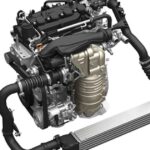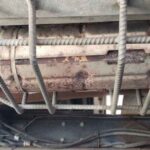Automotive batteries are typically classified as Hazard Class 8 – Corrosive Substances. This classification is due to the sulfuric acid electrolyte they contain, which is highly corrosive and can cause severe chemical burns. When transporting these batteries, specific packaging and labeling requirements must be followed to ensure safety.
The corrosive nature of the battery contents poses risks to human health and the environment if mishandled or damaged. Proper handling, storage, and disposal procedures are essential to mitigate these hazards and comply with regulations governing the transportation of dangerous goods.
What Are Hazardous Materials?
Before we jump into the specifics of automotive batteries, let’s unpack the concept of hazardous materials. These are substances that pose risks to health, safety, or the environment if not handled properly.
The U.S. Department of Transportation (DOT) takes these risks seriously, categorizing hazardous materials into distinct classes to ensure safe handling and transportation.
DOT classes of hazardous materials:
The DOT classifies hazardous materials into nine categories:
- Explosives
- Gases
- Flammable Liquids
- Flammable Solids
- Oxidizing Substances and Organic Peroxides
- Toxic Substances and Infectious Substances
- Radioactive Materials
- Corrosive Substances
- Miscellaneous Hazardous Materials
Each class has its own set of regulations and handling procedures. Automotive batteries fall into one of these categories—but which one? Let’s find out.
What Type is Automotive Battery

Automotive batteries come in various types, each with its own chemical composition and properties. The two most common types are:
- Lead-acid batteries: The traditional choice, found in most conventional vehicles.
- Lithium-ion batteries: Increasingly popular in electric and hybrid vehicles.
Lead-acid batteries contain sulfuric acid and lead, while lithium-ion batteries use a variety of lithium-based chemistries. Both types pose unique hazards, which is why they’re classified as hazardous materials.
Lead-Acid Batteries: The Traditional Powerhouse
Lead-acid batteries have been the go-to choice for vehicles for over a century. They’re reliable, relatively inexpensive, and can deliver the high current required to start an engine.
Their composition makes them inherently hazardous:
- Sulfuric acid electrolyte: Highly corrosive and can cause severe burns
- Lead plates: Toxic if ingested or inhaled as dust
- Hydrogen gas: Produced during charging, potentially explosive in confined spaces
Lithium-Ion Batteries: The New Kid on the Block
As electric vehicles gain popularity, lithium-ion batteries are becoming more common in the automotive world. They offer higher energy density and longer lifespan but come with their own set of hazards:
- Thermal runaway: Risk of overheating and fire
- Toxic electrolytes: Can be harmful if leaked
- Electrical hazards: High voltage systems pose shock risks
Automotive Batteries Are Which Hazard Class?
Lead-acid automotive batteries typically fall under Hazard Class 8: Corrosive Substances. This classification is due to the sulfuric acid electrolyte, which can cause severe burns and damage to living tissue and other materials.
“Corrosive materials are liquids or solids that cause full thickness destruction of human skin at the site of contact within a specified period of time.” – U.S. DOT
The corrosive nature of lead-acid batteries necessitates careful handling and specific safety measures:
- Always wear protective gloves and eyewear when handling
- Keep batteries upright to prevent acid leakage
- Neutralize acid spills immediately with baking soda or lime
- Never smoke or create sparks near batteries
Is a Car Battery a Hazardous Material?
In short, yes. Car batteries are considered hazardous materials due to their corrosive nature and potential to leak harmful substances. This classification isn’t meant to scare you but to ensure proper handling and disposal.
Consider these facts:
- A typical car battery contains about 21 pounds of lead and 1 gallon of sulfuric acid
- Improper disposal can lead to soil and water contamination
- Recycling car batteries is crucial for environmental protection
Automotive Batteries Are An Example Of Which Hazardous Class?
To reiterate, automotive batteries are primarily examples of Hazard Class 8 materials. This classification puts them in the same category as other corrosive substances like hydrochloric acid and sodium hydroxide.
Understanding this classification helps in:
- Proper storage and transportation
- Implementing correct safety measures
- Ensuring compliance with regulations
Lithium Batteries Belong To Which Hazard Class?
Lithium batteries, including those used in electric vehicles, belong to Hazard Class 9: Miscellaneous Hazardous Materials. This classification is due to their potential to overheat and ignite under certain conditions.
Key points about lithium battery hazards:
- Risk of thermal runaway and fire
- Potential for short circuits
- Challenges in fire suppression
What Hazard Class is Automotive Batteries
Let’s break down the hazard classifications for automotive batteries:
| Battery Type | Hazard Class | Reason for Classification |
| Lead-acid | Class 8 | Corrosive electrolyte |
| Lithium-ion | Class 9 | Fire and thermal runaway risk |
Understanding these classifications is crucial for proper handling, storage, and transportation of automotive batteries.
Automotive Batteries Are An Example Of Which Hazard Class (Walmart)
Major retailers like Walmart classify and handle automotive batteries according to DOT regulations. For lead-acid batteries, Walmart follows the Class 8 guidelines, ensuring proper storage and handling to prevent accidents and spills.
Walmart’s approach includes:
- Storing batteries in designated areas
- Training staff in proper handling procedures
- Offering battery recycling services to customers
More Post:
Julia Black Car Accident: A Heartbreaking Tale Of Promise Cut Short
Transportation of Hazardous Materials

Transporting automotive batteries requires adherence to specific guidelines:
- Use sturdy, non-conductive containers
- Secure batteries to prevent movement
- Label containers with appropriate hazard warnings
- Keep batteries upright to prevent leakage
- Follow specific airline regulations for air transport
Case Study: In 2016, the Federal Aviation Administration (FAA) banned the Samsung Galaxy Note 7 from all flights due to its lithium-ion battery’s tendency to overheat and catch fire.
This incident highlighted the importance of proper hazardous material classification and handling.
Air Transportation Challenges
Transporting batteries by air presents unique challenges:
- Pressure changes can affect battery integrity
- Limited fire suppression capabilities in cargo holds
- Proximity to other potentially reactive materials
As a result, strict regulations govern the air transport of batteries:
- Limits on the number of spare batteries allowed in carry-on luggage
- Requirements for batteries to be installed in devices when possible
- Prohibition of damaged or recalled batteries on aircraft
Road Transportation Considerations
While less restrictive than air transport, road transportation of automotive batteries still requires caution:
- Secure batteries to prevent shifting during transit
- Use appropriate packaging to contain potential leaks
- Display proper hazard placards on vehicles transporting large quantities
- Train drivers in emergency response procedures
Environmental Impact and Recycling
The hazardous nature of automotive batteries extends beyond immediate safety concerns to long-term environmental impacts. Proper disposal and recycling are crucial:
- Lead-acid batteries are nearly 100% recyclable
- Recycling reduces lead contamination in landfills and water sources
- Many states have laws mandating battery recycling
Did you know? The recycling rate for lead-acid batteries in the U.S. is over 99%, making them one of the most recycled consumer products.
The Recycling Process
- Batteries are broken apart in a hammer mill
- The lead, plastic, and other materials are separated
- Lead is melted and refined for use in new batteries
- Plastic is processed into pellets for new battery cases
- The acid is neutralized and treated
Safety Tips for Handling Automotive Batteries
Given their hazardous classification, it’s important to handle automotive batteries with care:
- Wear protective gear (gloves, goggles) when handling
- Keep batteries away from sparks and open flames
- Store in a cool, dry place
- Clean corrosion with a baking soda solution
- Never attempt to open or modify a battery
Future Trends in Automotive Battery Technology
As we look to the future, new battery technologies are emerging that may alter the landscape of hazardous material classification:
- Solid-state batteries: Potentially safer due to non-flammable electrolytes
- Flow batteries: Offer lower fire risk but present new handling challenges
- Sodium-ion batteries: A possible alternative to lithium, with different safety profiles
These emerging technologies may require updates to existing hazard classifications and handling procedures.
Also Read:
Jann Mardenborough’s Horrific Nürburgring Accident
FAQ’s
What hazard class is an automotive battery?
Automotive batteries are typically classified as Hazard Class 8 – Corrosive Substances due to the sulfuric acid electrolyte they contain.
What are the classifications of automotive batteries?
Automotive batteries are primarily classified as Hazard Class 8 (Corrosive Substances). They may also fall under Class 9 (Miscellaneous Dangerous Goods) depending on specific regulations.
What type of hazardous material is a battery?
Batteries are considered corrosive hazardous materials due to their sulfuric acid content. They can also be classified as miscellaneous dangerous goods in some contexts.
What hazard class is battery fluid in?
Battery fluid (electrolyte) is classified as Hazard Class 8 – Corrosive Substances, as it typically contains sulfuric acid which can cause severe chemical burns.
What is the class for batteries?
Batteries are generally classified as Hazard Class 8 (Corrosive Substances). In some cases, they may also be categorized as Class 9 (Miscellaneous Dangerous Goods).
What category is batteries?
Batteries fall into the category of Hazard Class 8 – Corrosive Substances. They may also be categorized as Class 9 – Miscellaneous Dangerous Goods in certain regulatory contexts.
Conclusion
Understanding the hazard class of automotive batteries is more than just technical knowledge it’s a crucial aspect of vehicle ownership and safety. Whether you’re dealing with a traditional lead-acid battery or a modern lithium-ion power source, knowing its classification helps ensure proper handling, storage, and disposal.
Remember:
- Lead-acid batteries are Class 8 (Corrosive)
- Lithium-ion batteries are Class 9 (Miscellaneous)
- Proper handling and disposal are essential for safety and environmental protection
By staying informed about these classifications, you’re not just being a responsible vehicle owner, you’re contributing to a safer, more sustainable automotive future. As battery technology continues to evolve, staying updated on the latest safety guidelines and hazard classifications will be more important than ever.
Whether you’re a driver, mechanic, or simply someone interested in automotive technology, this knowledge empowers you to handle these powerful energy sources with the respect and caution they deserve.







